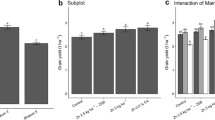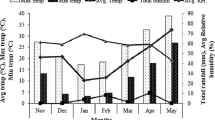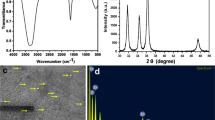Abstract
Zinc deficiency in human nutrition is widespread in developing Asian and African countries where cereal grains are the staple food. Agronomic biofortification of Zn is a new innovative approach to get rid of Zn malnutrition from the poorest of the poor rural masses, who will never have money to buy mineral supplements nor can afford to improve the components of their diet by incorporating animal products. Hence, a field experiment was conducted during 2010 and 2011 on a sandy clay-loam soil (typic Ustochrept) at New Delhi, India to study the effect of NPK fertilization and to compare zinc sulphate heptahydrate (ZnSHH) and Zn–EDTA for growth, yield attributes, grain and straw yield, Zn concentration and uptake and Zn use efficiency in Basmati rice cultivar ‘Pusa Sugandh 5’ when applied to soil ZnSHH and Zn–EDTA were equally effective. Three foliar applications of ZnSHH increased Zn concentration and uptake by rice as compared to its soil application. Three foliar applications of Zn–EDTA (at tillering, booting and grain filling stages) was the best treatment and recorded significantly better growth, higher values for yield attributes, higher grain and straw yield and higher concentration and uptake of Zn in grain and straw of Basmati rice than soil application of ZnSHH or Zn–EDTA and two or a single foliar application of ZnSHH or Zn–EDTA. Three foliar applications of 0.5 % solution of Zn–EDTA recorded significantly higher head rice recovery than soil application. The highest KLBC, KLAC and KLER were obtained with three foliar applications of 0.5 % solution of Zn–EDTA.
Similar content being viewed by others
References
Cakmak I (2008) Enrichment of cereal grains with zinc: agronomic or genetic biofortification? Plant Soil 302:1–7
Hotz C, Brown KH (2004) Assessment of the risk of zinc deficiency in populations and options for its control. Food Nutr Bull 25:194–204
Stein AJ, Nestel P, Meenakshi JV, Qaim M, Sachdev HPS, Bhutta ZA (2007) Plant breeding to control zinc deficiency in India: how cost effective is biofortification. Public Health Nutr 106:492–501
Black R, Lindsay HA, Bhutta ZA, Caulfield LE, DeOnnis M, Ezzat M, Mathers F, Rivera J (2008) Maternal and child under nutrition: global and regional exposures and health consequences. Lancet 371:243–260
Fischer WCL, Black RE (2007) Functional indicators for assessing zinc deficiency. Food Nutr Bull 28(3 Suppl.):S454–S479
Graham RD, Welch RM, Bouis HE (2001) Addressing micronutrient malnutrition through enhancing the nutritional quality of staple foods: principles, perspectives and knowledge gaps. Adv Agron 70:77–142
IRRI (2006) Bringing hope, improving lives: Strategic Plan 2007-2015. International Rice Research Institute, Manila, p 61
McLean JL, Dawe DC, Hardy B, Hettel CP (2002) Rice Almanac, 3rd edn. CABI Publishing, Wallingford
Bell DW, Dell B (2008) Micronutrients for sustainable food, feed, fibre and bioenergy products. International Fertilizer Industry Association, Paris, p 175
Graham RD (2008) Micronutrient deficiencies in crops and their global significance. In: Alloway BJ (ed) Micronutrient deficiencies in global crop production. Springer, Dordrecht, pp 41–61
Prasad R, Shivay YS, Kumar D (2013) Zinc fertilization of cereals for increased production and alleviation of zinc malnutrition in India. Agric Res 2:111–118
Prasad R (2006) Zinc in soils and in plant, human and animal nutrition. Indian J Fertil 2(9):103–119
Prasad R, Shivay YS, Kumar D (2014) Agronomic biofortification of cereal grains with iron and zinc. Adv Agron 125:55–91
Shivay YS, Kumar D, Ahlawat IPS, Prasad R (2007) Relative efficiency of ZnO and zinc sulphate coated urea for rice. Indian J Fertil 3(2):51–55
Chatterjee AK, Mandal LN (1985) Zinc sources for rice in soil at different moisture regimes and organic matter levels. Plant Soil 87:393–404
Diaz DR (2012) Foliar feeding of micronutrients in wheat www.agronomy.ksu.edu/extension(ruidiaz@ksu.edu). Accessed 1 Aug 2014
Boonchuay P, Cakmak I, Rerkasem B, Pram-U-Thai C (2013) Effect of different zinc applications at different growth stages on seed zinc content and its impact on seedling growth and vigor in rice. Soil Sci Plant Nutr 59:180–188
Prasad R, Shivay YS, Kumar D, Sharma SN (2006) Learning by doing exercise in soil fertility—a practical manual for soil fertility. Division of Agronomy, IARI, New Delhi
Shivay YS, Prasad R, Rahal A (2010) Genotypic variation for productivity, zinc utilization efficiencies and kernel quality in rices under low available zinc conditions. J Plant Nutr 33:1835–1848
Satake T (1990) Modern rice milling technology. University of Tokyo Press, Tokyo
Juliano BO, Perez CM (1984) Results of collaborative test on the measurement of grain elongation of milled rice during cooking. J Cereal Sci 2:281–292
Gomez KA, Gomez AA (1984) Statistical procedures for agricultural research. Wiley, New York
Pal NC, Sarkar MAR, Hossain MZ, Barman SC (2008) Root growth of four aman rice varieties as influenced by NPK fertilization. J Bangladesh Agric Univ 6:235–238
Rattan RK, Datta SP, Saharan N, Katyal JC (1997) Zinc in Indian agriculture-a look forward. Fertil News 42(12):75–89
Rehm G, Schmitt M (1997) Zinc for crop production. University of Minnesota Extension, Falcon Heights (ww00720 GO)
Karak T, Singh UK, Das DK, Kuzyakov Y (2005) Comparative efficiency of zinc sulphate and Zn–EDTA for fertilization of rice (Oryza sativa L). Arch Agron Soil Sci 51:253–264
Dhaliwal SS, Sadana US, Khurana MPS, Dhadli HS, Manchanda JS (2010) Enrichment of rice grains through ferti-fortification. Indian J Fertil 6(7):28–35
Phattarakul N, Rerkasem B, Li LJ, Wu LH, Zou CQ, Ram H, Sohu VS, Kang BS, Surek H, Kalayci M, Yazici A, Zhang FS, Cakmak I (2012) Biofortification of rice grain with zinc through zinc fertilization indifferent countries. Plant Soil 361:131–141
Yuan L, Wu L, Yang C, Lv Q (2013) Effect of iron and zinc foliar applications on rice plants and their grain accumulation and grain nutritional quality. J Sci Food Agric 93:254–261
Shivay YS, Prasad R (2012) Zinc-coated urea improves productivity and quality of Basmati rice (Oryza sativa L.) under zinc stress condition. J Plant Nutr 35:928–951
Acknowledgment
Sincere thanks are due to Director, Joint Director Research and Head, Division of Agronomy, Indian Agricultural Research Institute, New Delhi for their advice and support.
Author information
Authors and Affiliations
Corresponding author
Rights and permissions
About this article
Cite this article
Shivay, Y.S., Prasad, R., Kaur, R. et al. Relative Efficiency of Zinc Sulphate and Chelated Zinc on Zinc Biofortification of Rice Grains and Zinc Use-Efficiency in Basmati Rice. Proc. Natl. Acad. Sci., India, Sect. B Biol. Sci. 86, 973–984 (2016). https://doi.org/10.1007/s40011-015-0544-7
Received:
Revised:
Accepted:
Published:
Issue Date:
DOI: https://doi.org/10.1007/s40011-015-0544-7




